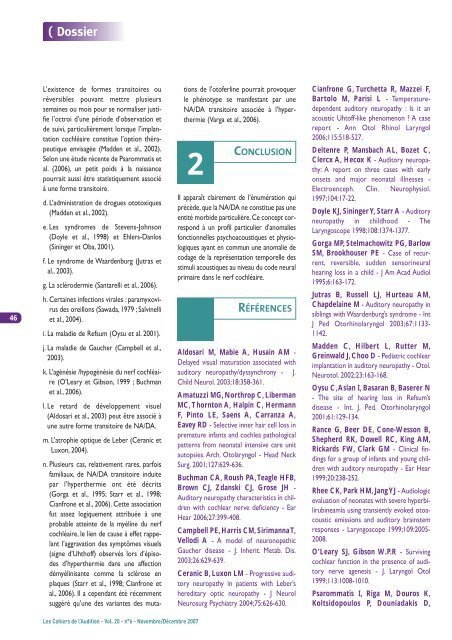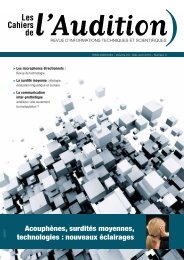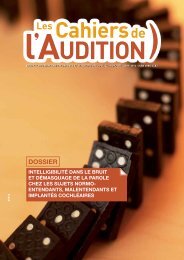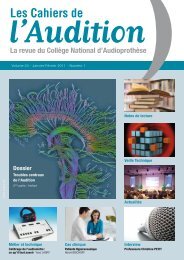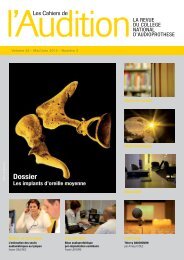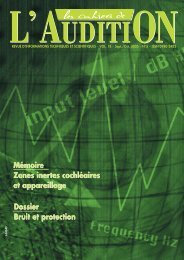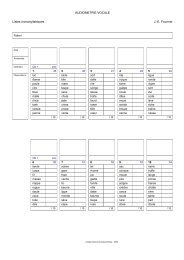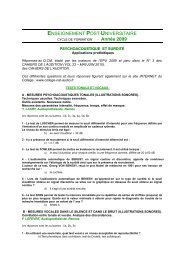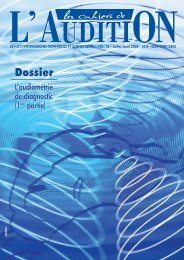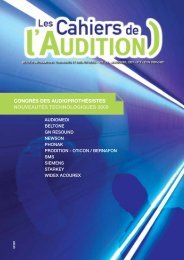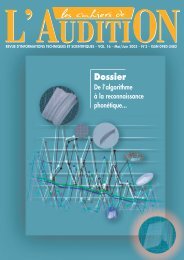la neuropathie auditive / désynchronisation auditive - Collège ...
la neuropathie auditive / désynchronisation auditive - Collège ...
la neuropathie auditive / désynchronisation auditive - Collège ...
You also want an ePaper? Increase the reach of your titles
YUMPU automatically turns print PDFs into web optimized ePapers that Google loves.
( Dossier46L’existence de formes transitoires ouréversibles pouvant mettre plusieurssemaines ou mois pour se normaliser justifiel’octroi d’une période d’observation etde suivi, particulièrement lorsque l’imp<strong>la</strong>ntationcochléaire constitue l’option thérapeutiqueenvisagée (Madden et al., 2002).Selon une étude récente de Psarommatis etal. (2006), un petit poids à <strong>la</strong> naissancepourrait aussi être statistiquement associéà une forme transitoire.d. L’administration de drogues ototoxiques(Madden et al., 2002).e. Les syndromes de Stevens-Johnson(Doyle et al., 1998) et Ehlers-Danlos(Sininger et Oba, 2001).f. Le syndrome de Waardenburg (Jutras etal., 2003).g. La sclérodermie (Santarelli et al., 2006).h. Certaines infections virales : paramyxovirusdes oreillons (Sawada, 1979 ; Salvinelliet al., 2004).i. La ma<strong>la</strong>die de Refsum (Oysu et al. 2001).j. La ma<strong>la</strong>die de Gaucher (Campbell et al.,2003).k. L’agénésie /hypogénésie du nerf cochléaire(O’Leary et Gibson, 1999 ; Buchmanet al., 2006).l. Le retard de développement visuel(Aldosari et al., 2003) peut être associé àune autre forme transitoire de NA/DA.m. L’atrophie optique de Leber (Ceranic etLuxon, 2004).n. Plusieurs cas, re<strong>la</strong>tivement rares, parfoisfamiliaux, de NA/DA transitoire induitepar l’hyperthermie ont été décrits(Gorga et al., 1995; Starr et al., 1998;Cianfrone et al., 2006). Cette associationfut assez logiquement attribuée à uneprobable atteinte de <strong>la</strong> myéline du nerfcochléaire, le lien de cause à effet rappe<strong>la</strong>ntl’aggravation des symptômes visuels(signe d’Uhthoff) observés lors d’épisodesd’hyperthermie dans une affectiondémyélinisante comme <strong>la</strong> sclérose enp<strong>la</strong>ques (Starr et al., 1998; Cianfrone etal., 2006). Il a cependant été récemmentsuggéré qu’une des variantes des muta-tions de l’otoferline pourrait provoquerle phénotype se manifestant par uneNA/DA transitoire associée à l’hyperthermie(Varga et al., 2006).2CONCLUSIONIl apparaît c<strong>la</strong>irement de l’énumération quiprécède, que <strong>la</strong> NA/DA ne constitue pas uneentité morbide particulière. Ce concept correspondà un profil particulier d’anomaliesfonctionnelles psychoacoustiques et physiologiquesayant en commun une anomalie decodage de <strong>la</strong> représentation temporelle desstimuli acoustiques au niveau du code neuralprimaire dans le nerf cochléaire.RÉFÉRENCESCianfrone G, Turchetta R, Mazzei F,Bartolo M, Parisi L - Temperaturedependentauditory neuropathy : Is it anacoustic Uhtoff-like phenomenon ? A casereport - Ann Otol Rhinol Laryngol2006;115:518-527.Deltenre P, Mansbach AL, Bozet C,Clercx A, Hecox K - Auditory neuropathy:A report on three cases with earlyonsets and major neonatal illnesses -Electroenceph. Clin. Neurophysiol.1997;104:17-22.Doyle KJ, Sininger Y, Starr A - Auditoryneuropathy in childhood - TheLaryngoscope 1998;108:1374-1377.Gorga MP, Stelmachowitz PG, BarlowSM, Brookhouser PE - Case of recurrent,reversible, sudden sensorineuralhearing loss in a child - J Am Acad Audiol1995;6:163-172.Jutras B, Russell LJ, Hurteau AM,Chapde<strong>la</strong>ine M - Auditory neuropathy insiblings with Waardenburg’s syndrome - IntJ Ped Otorhino<strong>la</strong>ryngol 2003;67:1133-1142.Madden C, Hilbert L, Rutter M,Greinwald J, Choo D - Pediatric cochlearimp<strong>la</strong>ntation in auditory neuropathy - Otol.Neurotol. 2002;23:163-168.Oysu C,As<strong>la</strong>n I, Basaran B, Baserer N- The site of hearing loss in Refsum’sdisease - Int. J. Ped. Otorhino<strong>la</strong>ryngol2001;61:129-134.Rance G, Beer DE, Cone-Wesson B,Shepherd RK, Dowell RC, King AM,Rickards FW, C<strong>la</strong>rk GM - Clinical findingsfor a group of infants and young childrenwith auditory neuropathy - Ear Hear1999;20:238-252.Rhee CK, Park HM, Jang YJ - Audiologicevaluation of neonates with severe hyperbilirubineamiausing transiently evoked otoacousticemissions and auditory brainstemresponses - Laryngoscope 1999;109:2005-2008.O’Leary SJ, Gibson W.P.R - Survivingcochlear function in the presence of auditorynerve agenesis - J. Laryngol Otol1999;113:1008-1010.Psarommatis I, Riga M, Douros K,Koltsidopoulos P, Douniadakis D,Aldosari M, Mabie A, Husain AM -De<strong>la</strong>yed visual maturation associated withauditory neuropathy/dyssynchrony - J.Child Neurol. 2003;18:358-361.Amatuzzi MG, Northrop C, LibermanMC, Thornton A, Halpin C, HermannF, Pinto LE, Saens A, Carranza A,Eavey RD - Selective inner hair cell loss inpremature infants and cochlea pathologicalpatterns from neonatal intensive care unitautopsies. Arch. Oto<strong>la</strong>ryngol - Head NeckSurg. 2001;127:629-636.Buchman CA, Roush PA,Teagle HFB,Brown CJ, Zdanski CJ, Grose JH -Auditory neuropathy characteristics in childrenwith cochlear nerve deficiency - EarHear 2006;27:399-408.Campbell PE, Harris CM, Sirimanna T,Vellodi A - A model of neuronopathicGaucher disease - J. Inherit. Metab. Dis.2003;26:629-639.Ceranic B, Luxon LM - Progressive auditoryneuropathy in patients with Leber’shereditary optic neuropathy - J NeurolNeurosurg Psychiatry 2004;75:626-630.Les Cahiers de l’Audition - Vol. 20 - n°6 - Novembre/Décembre 2007


